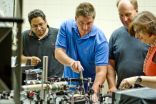The investigators used a drug to block production of this substance in mouse models, staving off damage to insulin-producing cells and preventing the onset of the autoimmune disorder. The drug, which is currently used in Europe and Asia for treating gallstone-related spasms, has an excellent safety record, the researchers said.
The findings, described in a study to be published online Sept. 14 in the Journal of Clinical Investigation, suggest that it may be possible to prevent the onset of Type 1 diabetes in humans if a similar treatment is initiated before the insulin-producing cells, or beta cells, are attacked by misguided immune cells. Type 1 diabetes, formerly called juvenile diabetes, afflicts one in 300 people in the United States.
The study is the first to link the progression of Type 1 diabetes to changes in the architecture of the extracellular matrix, the carbohydrate- and protein-rich lattice in which the cells composing our tissues are embedded, said Paul Bollyky, MD, PhD, assistant professor of infectious diseases. Bollyky is the study's senior author. The lead author is postdoctoral scholar Nadine Nagy, PhD.
Most pancreatic cells are engaged in manufacturing and secreting digestive enzymes. But the pancreas is also studded with tiny, hormone-producing cell clusters called islets. A human pancreas contains thousands of islets, scattered throughout the organ like raisins in a loaf of cinnamon bread.
Inflamed islets
A pancreatic islet is composed of several cell types, each making a different hormone. Beta cells, for example, produce insulin.
"In Type 1 diabetes, only the beta cells get destroyed," said Bollyky. Why this happens is poorly understood. But it's known that during the disorder's early, pre-symptomatic stage, pancreatic islets become inflamed -- that is, they get infiltrated by immune cells. At first quiescent, these warrior cells at some point begin attacking beta cells, eventually destroying enough of them to effectively erase insulin output. By the time a person begins to manifest the disease's hallmark symptom, chronic hyperglycemia, some 90 percent of pancreatic beta cells have been killed off. Neither the cause of immune cells' initial infiltration of pancreatic islets nor the trigger for their transition from mere passive presence to active aggression is yet understood.
But the new study provides important clues.
In a 2014 study, Bollyky's team measured the levels of dozens of substances in the extracellular matrix of human postmortem pancreatic tissue. One substance, called hyaluronan, was overly abundant near the pancreatic beta cells of people with Type 1 diabetes. But this was seen only in pancreatic tissue from patients who had been somewhat recently diagnosed, not patients who'd lived with the disease for decades.
Hyaluronan is usually present at trace concentrations in the extracellular matrix that pervades all tissues. But hyaluronan levels spike markedly at the site of an injury. "If you twist your ankle or stub your toe, that swelling you see afterwards is due to hyaluronan," Bollyky said. This substance is prone to soaking up water, causing fluid buildup in the injured region, a cardinal feature of inflammation.
Bollyky said the absence of increased hyaluronan in long-term patients' pancreatic islets didn't mean much, as these people's beta cells had long since bit the dust. But finding excessive deposits of hyaluronan near pancreatic beta cells in recent-onset cases was intriguing.
Curious, Bollyky and his colleagues sought to determine whether this association was incidental or whether hyaluronan's increased presence actually played any causal role. So, they employed a bioengineered strain of laboratory mouse whose immune system is guaranteed to attack its pancreatic beta cells. Essentially 100 percent of these mice eventually develop Type 1 diabetes, and always over about the same period of time, making it easy to study the effects of an experimental manipulation upon the disease's progression.
The scientists also looked at another mouse strain often afflicted with a version of Type 1 diabetes that more closely parallels the human form of the disease. (These mice are tougher to study because only about half of them contract the disease, and they do so at variable rates.)
In both strains, Bollyky said, hyaluronan accumulated in pancreatic islets, but not in all of them -- just in those where inflammatory immune cells had parked themselves. No excessive hyaluronan deposition was seen in the mice's heart, lung or liver tissue, consistent with the idea that the phenomenon occurs only in inflamed tissues. The islet-associated hyaluronan buildup eventually crescendoed and began tapering off, analogous to the investigators' observations in recent-onset versus long-established Type 1 diabetes cases in their earlier study of human tissue.
Preventing hyaluronan buildup
"We wondered what would happen if we prevented that buildup," Bollyky said. "And we knew a drug that does that." The drug was hymecromone, or 4-methylumbelliferone (4-MU for short). Prescribed in many European and Asian countries for painful, gallstone-associated spasms and sold by about 60 companies worldwide for research purposes, 4-MU inhibits hyaluronan synthesis. It is inexpensive, can be given orally and, over four decades of use, has what Bollyky described as an "extremely boring safety profile": a very low rate of associated adverse events. "It's even approved in Europe for kids," he said. (The Food and Drug Administration has not licensed 4-MU for any indication in the United States.)
In the mice used in the study, as in people, there's a window of time during which immune cells have infiltrated pancreatic islets but most beta cells are still intact. When the researchers initiated 4-MU treatment before the majority of the mice's beta cells had been wiped out, none of the mice developed hyperglycemia. Mice that didn't get 4-MU did. If mice stayed on a 4-MU regimen, they remained diabetes-free for at least a year. But if the regimen was stopped, they quickly became diabetic.
Tissue analysis revealed the continued presence of immune cells situated close to beta cells even in mice getting 4-MU, but the beta cells themselves seemed normal; the immune cells had evidently refrained from attacking them. The scientists also found reduced hyaluronan levels in 4-MU-treated mice's pancreatic islets, indicating that the drug was performing as expected.
Further experiments in the mice showed that hyaluronan prevents the induction of a class of regulatory immune cells, known as Tregs, whose job is to rein in their aggressive fellow immune cells and keep them from damaging healthy tissue. Bollyky likened Tregs' function to that of military police. In the absence of appropriate supervision, immune cells can get trigger-happy, he said. But by impeding hyaluronan synthesis, 4-MU re-establishes the induction of enough Tregs to prevent beta-cell destruction.
No drug has previously been shown to do this in humans, Bollyky said. His group has received preliminary funding from SPARK, a Stanford-based program devoted to fostering drug-development entrepreneurship, and is working with the FDA in preparation for a clinical trial of 4-MU for preventing Type 1 diabetes. The Stanford Office of Technology Licensing has applied for a use patent on associated intellectual property.
INFORMATION:
The study was performed in collaboration with scientists at the Benaroya Research Institute under the direction of matrix biologist Thomas Wight, PhD, whose group Bollyky was associated with when the work began. Funding for the study came from the Juvenile Diabetes Research Foundation and the National Institutes of Health (grants R01DK096087-01, R01HL113294 and U01AI101984).
Other Stanford-affiliated co-authors are postdoctoral scholar Vivekananda Sunkari, PhD, and basic life science research associates Gernot Kaber, PhD, and Hedwich Kuipers, PhD.
Stanford's Department of Medicine also supported the work.
The Stanford University School of Medicine consistently ranks among the nation's top medical schools, integrating research, medical education, patient care and community service. For more news about the school, please visit http://med.stanford.edu/school.html. The medical school is part of Stanford Medicine, which includes Stanford Health Care and Lucile Packard Children's Hospital Stanford. For information about all three, please visit http://med.stanford.edu.
Print media contact: Bruce Goldman at (650) 725-2106 (goldmanb@stanford.edu)
Broadcast media contact: Margarita Gallardo at (650) 723-7897 (mjgallardo@stanford.edu)


